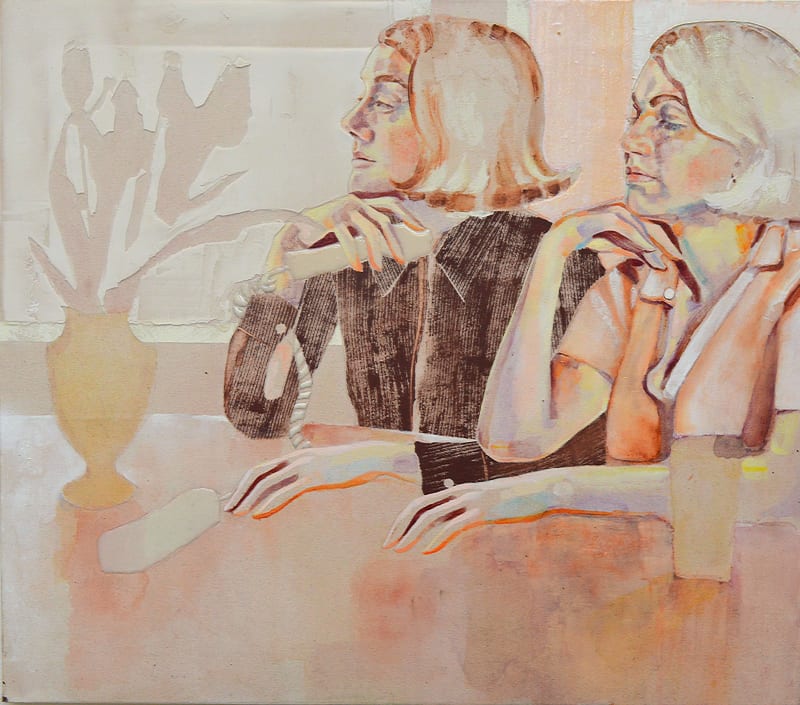Private View: Wednesday, 25th of January 2023, 6:30 - 9pm
London (London Bridge)
The Nigeria-based artist Kwadwo A. Asiedu’s practice is rooted in an intimate exploration of place. Through undulating, abstracted landscapes that play with elements of flora and fauna at different scales, he considers humanity’s position within nature and our need to cultivate a more sustainable and respectful relationship to the earth. The Chicago-based artist Laura Berger also paints dreamlike environments though the scenes that she creates respond less to the natural world and more to psychological experiences or memories. In her work, large-scale, translucent figures appear intertwined and overlapping, the curves of their limbs appearing both elemental and eternal.
Richard Burton’s luminous, sci-fi-inspired scenes are populated with repetitive figures and forms – the silky backs of heads or rows of empty upholstered chairs. Occupying a place between the familiar and the strange, his paintings consider the human desire for comfort and connection in contrast to the sterile built environments in which we live and work. Ferdinand Dölberg is similarly preoccupied with social structures and systems of power. Influenced by the Dadaist movement which celebrated experimentation, flux and absurdity in opposition to the rigid structures of the capitalist society in the 20th century, Dölberg renders fragmented figures and body parts on checkered backdrops that allude to play as a tool for disruption and the creative potential of the accidental. The Brazilian artist Paula Turmina’s practice is also concerned with the histories and forms of power. Favouring a warm, earthy colour palette, her surreal painted scenes consider the human relationship to land, often evoking a slippage between the body, landscape, plants and animals.
The Austrian artist Bertram Hasenauer works with a highly controlled colour palette that’s characterised by black and white, but also intense shades of red, blue and yellow. The faces and limbs in his work often appear semi-translucent, as if they are emerging from or dissolving back into the colours from which they are formed. Colour is also one of the driving principles behind the work of Ukrainian artist Vova Keno whose fluid, intuitive approach to painting is influenced by a background in graffiti and street art. Each of his paintings is born out of a spontaneous process of experimentation and play. The Bavarian artist Maximilian Magnus embraces a similarly instinctive approach to painting that often involves stapling unstretched canvas onto the floor or the wall. This allows the artist to use his whole body to create dynamic, sweeping gestures that hold not only traces of his physicality but also a powerful emotional resonance.
Rosalind Howdle plays on the tradition of still life painting to explore notions of the uncanny. In her work, floral forms appear overblown and almost bacterial, rendered in nocturnal shades of deep purple and blue with touches of fluorescence. Celina Teague’s surreal, otherworldly scenes similarly employ elements of humour and horror to reflect on how the dissemination of information affects the way we relate and respond to catastrophic events. Each of her paintings takes its cue from current affairs – environmental issues, but also political and humanitarian crises – to consider notions of activism, guilt and responsibility. Though vastly different in style, Anna Woodward’s fantastical worlds also explore the relationship between the natural and the manmade. In her paintings, snaking, biomorphic forms, lush plant life and jutting metallic rods come together in complex, tangled environments.
Zemba Luzamba’s paintings begin as a written concepts, often inspired by specific social, cultural, and political movements or activities. However, the artist deliberately removes contextual background detail to focus the viewer’s attention on the human aspects – body language, clothing, facial expressions – and to create space for interpretation. Rendered in a bold, graphical style, his work delves into the subtleties of how we relate to and make sense of the world around us. Mary Macken Allen’s tender painted scenes also explore human relationships and the fluid boundaries of self. While each encounter or interaction occurs within a recognisable domestic space, translucent layers of oil paint and soft, yellow-tinted hues create a strange sense of ephemerality and solitude. Meanwhile, Tom White is interested in how the materiality of paint and its movement across the canvas can capture the essence of a person. White paints those who are closest to him and as such, each portrait is also an invitation to share in a moment of intimacy and trust. Alexandra Searle is the only sculptor included in the exhibition and her work is rooted in the body both in terms of subject matter and material. Drawing on a diverse range of references from the medical and psychological to her own experiences of anxiety and hypochondria, Searle’s visceral sculptural forms depict moments of stress, tension and expectation.
Bringing together some of the most exciting international artistic talent, Tomorrow is Tomorrow is Tomorrow is a vision of a wonderfully bright and varied future.
















